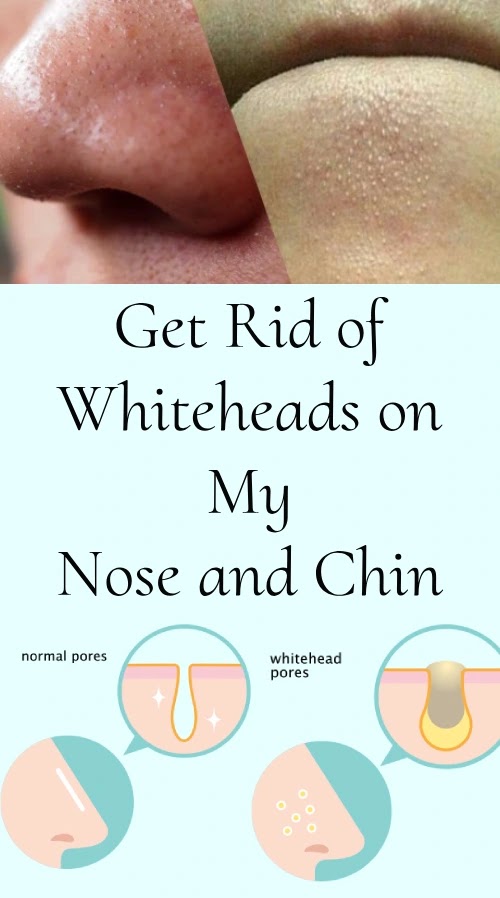 |
| How do I Get Rid of Whiteheads on My Nose and Chin |
Whiteheads and blackheads are common skin problems that often appear on the chin and nose. Because of this, the beauty of the face also gets affected. Your face looks rough and blotchy. Whiteheads are under the upper layer of the skin. These are not easily visible but can be felt on the nose and chin when touched. {Read This: Remove blackheads and whiteheads ~ Cornmeal to get rid of blackheads }
Don't want to face the problem of whiteheads/blackheads. Here, we share information about how to get rid of whiteheads from the nose and chin. These home tips and remedies will help in removing whiteheads.
Whiteheads
Whiteheads, also known as closed comedones, are a type of acne. These appear small and slightly raised on the surface of the skin. Whiteheads close on the surface of the skin. Whiteheads are usually found on the face, especially the nose and chin, but they can also occur on the chest, back, and other parts of the body. {Read This: How To Get Rid of Blackheads on Nose Permanently}
Causes of whiteheads
- Excess Sebum Production: Sebum is an oily substance produced by the sebaceous glands in the skin. When the production of sebum is excessive, it can mix with dead skin cells and clog hair follicles, leading to the formation of whiteheads.
- Dead Skin Cell Buildup: The outer layer of our skin constantly sheds dead skin cells. If these cells are not properly sloughed off, they can accumulate and contribute to the blockage of hair follicles.
- Bacterial Presence: Bacteria, particularly a type known as Propionibacterium acnes, can play a role in the development of whiteheads. When trapped within a clogged follicle, bacteria can multiply and cause inflammation.
- Hormonal Fluctuations: Hormonal changes, especially during puberty, menstruation, pregnancy, and conditions like polycystic ovary syndrome (PCOS), can lead to an increase in sebum production, making individuals more prone to developing whiteheads.
- Certain Medications: Some medications, like corticosteroids, can lead to increased oil production and a higher likelihood of developing whiteheads.
- Diet and Lifestyle Factors: Although the direct link between diet and acne is not fully understood, some studies suggest that high-glycemic index foods and dairy products may contribute to acne development in certain individuals.
- Genetics: Some people may be genetically predisposed to having a higher likelihood of developing acne, including whiteheads.
- Environmental Factors: Exposure to certain environmental factors like pollution and humidity can contribute to the development of whiteheads.
- Improper Skincare: Using harsh or comedogenic (pore-clogging) skincare products can exacerbate whiteheads. Additionally, not cleansing the skin properly can lead to a buildup of oil and dead skin cells.
- Stress: High levels of stress can lead to an increase in the production of certain hormones, such as cortisol, which may stimulate the sebaceous glands and contribute to acne, including whiteheads.
How do I Get Rid of Whiteheads on My Nose and Chin
 |
| How do I Get Rid of Whiteheads on My Nose and Chin |
Having clear skin is important to get rid of whiteheads on the nose and chin. Here are some steps you can follow to treat whiteheads at home:
1. Cleanse your Face: Use a gentle cleanser twice a day to remove excess oil, dirt and bacteria from the skin.
2. Exfoliate Regularly: Do exfoliation once a week. Exfoliation helps in removing dead skin cells and gets rid of whiteheads. You can also use homemade scrub.
Note: Do not overdo the exfoliation, as excessive exfoliation can irritate.
3. Do not Touch your Face Frequently: Do not touch your face with your hands frequently. Try to avoid touching your face as much as possible. Touching the face with hands can bring bacteria, which can increase the problem of whiteheads.
4. Use a Clay Mask: Applying a clay mask once or twice a week can help absorb excess oil and unclog pores. Look for masks containing ingredients like kaolin or bentonite clay. {Read This: DIY Clay Face Mask | Homemade Clay Face Mask Recipe}
5. Steam Your Face: Steaming your face can help open up pores, making it easier to remove impurities. Fill a bowl with hot water, lean over it with a towel draped over your head to trap the steam, and let your face absorb the steam for about 5-10 minutes. Be cautious not to get too close to the hot water to avoid burning your skin.
6. Tea Tree Oil: Known for its antimicrobial properties, tea tree oil can help kill bacteria and reduce inflammation. Dilute it with a carrier oil (like jojoba or coconut oil) before applying it to the affected areas. {Read This: Green Tea Face Pack For Skin Whitening~ Amazing Green Tea Face Pack}
7. Maintain a Clean Pillowcase: Regularly changing your pillowcase can prevent dirt, oil, and bacteria from transferring back onto your skin as you sleep.
8. Maintain a Healthy Diet and Lifestyle: Eating a balanced diet, staying hydrated, getting regular exercise, and managing stress can contribute to overall skin health.
9. Moisturize: Even if you have oily skin, using a lightweight, oil-free moisturizer can help maintain skin hydration and prevent excessive dryness, which can lead to increased oil production.
10. Avoid Picking or Squeezing: This can lead to further irritation, inflammation, and potential scarring. It's best to leave whiteheads alone and let them resolve naturally or with treatment.
11. Get Good Sleep: Get at least 7-8 hours of quality sleep every night. Proper or good sleep helps to balance the hormone levels. It can affect the skin health and give you healthy skin.
12. Avoid Excessive Washing: Avoid washing the face frequently. This can remove too much of the natural oil from your face and worsen the condition of your skin. Just follow your morning and evening skincare routine.





0 Comments